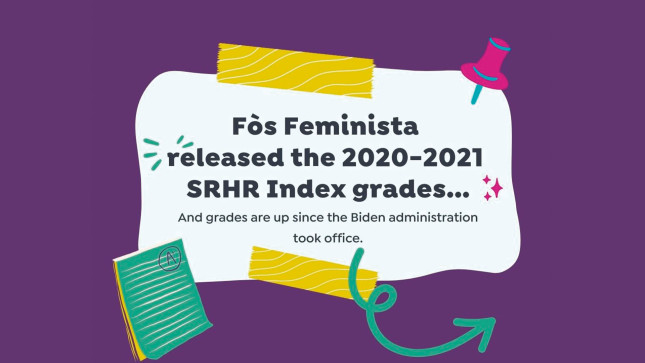-
The Grades Are In: The Biden Administration Makes Progress on SRHR
October 19, 2022 By Deekshita Ramanarayanan
For six years, the Sexual and Reproductive Health and Rights (SRHR) Index has been a tool to hold the United States accountable to the commitments made nearly three decades ago at the International Conference on Population and Development (ICPD) in Cairo in 1994, where 180 countries developed a human rights framework for global development that explicitly promoted SRHR for women and girls globally.
The SRHR Index was originally developed in 2018 by the Center for Health and Gender Equity (CHANGE) – now part of Fòs Feminista – and the Global Women’s Institute at the George Washington University, and grades the U.S. government’s policies and budgets related to SRHR globally.
Speaking at the launch event of the 2021 SRHR Index, Bergen Cooper, Director of Policy Research at Fòs Feminista, noted that the measure “is a tool to hold [the U.S. government] accountable for their actions related to Global Health while outlining clear, realistic, and achievable recommendations to promote sexual and reproductive health and rights through U.S. global assistance.”
However, the United States has not always upheld its commitment to SRHR. The adoption of the Hyde and Helms amendments, the Mexico City Policy (also known as the Global Gag Rule), and the recent Supreme Court decision to overturn Roe v. Wade—a landmark case which established the constitutional right to an abortion in the United States—are all instances in which the U.S. has not done so.
“Decades of experience and research on the Helms Amendment and the Global Gag Rule have shown how the U.S. has used its power restricting access to SRHR by imposing very dogmatic fundamentalist views on women, girls, and gender diverse people most impacted by these inequalities,” said Giselle Carino, Director and Chief Executive Officer of Fòs Feminista.
Indeed, it was not until 2021 that the White House, under President Joseph Biden, explicitly committed to supporting SRHR domestically and globally. So how has this renewed U.S. pledge been reflected in the latest SRHR Index?

Taking Measure
The SRHR Index uses standardized indicators to assess the actions and funding levels across actors and domains. The six actors graded in the Index are the White House, Congress, Department of State, U.S. Agency for International Development (USAID), Department of Health and Human Services (HHS), and Department of Defense (DOD).
“SRHR is everywhere, and the SRHR Index captures that,” said Cooper.
These actors are graded across three domains—HIV and AIDS, maternal and child health, and family planning – the core funding streams of U.S. global health assistance related to SRHR. The Index analyzes publicly available actions on the basis of whether they are evidence based, responsive to demonstrated need, consistent with internationally recognized human rights principles, and gender transformative. The Index also analyzes data on budgets and investments from each actor across each domain they work in. The actors are also graded on the availability and quality of data related to each domain.
“It is a methodology that allows you to compare what is being done to what could, or should be being done,” said Cooper.
One aspect of U.S. global health policy that the Index seeks to highlight is the siloed nature of global health assistance. Though funding streams are largely split into the three domains graded by the Index, global health programs often do not fit neatly into one domain – as evidenced by the fact that nearly every policy graded for 2021 is graded across multiple domains. Additionally, global health programs relevant to SRHR may fall under one of many cross-cutting issues, such as gender-based violence, nutrition, and tuberculosis. Therefore, it is imperative that policies take a comprehensive approach to addressing all relevant aspects of SRHR.
Tracking Progress Over Time
The SRHR Index provides grades for all actors and domains from 2016 to 2021, and includes a “baseline” to factor in all relevant policies dating back to the Foreign Assistance Act of 1961. The recent launch event released the grades for 2020 and 2021, reflecting the difference between the last year of the Trump Administration and the first of the Biden Administration.
What did this research reveal? The White House’s grade rose significantly from a D average in 2020 to a B- average in 2021, due to President Biden’s demonstrated commitment to SRHR globally through the White House Gender Policy Council, the revocation of the Global Gag Rule, and the Administration’s affirmative statement in support of SRHR domestically and globally.
While grades for the White House generally fluctuate based on a U.S. President’s agenda, the grades for the Department of State, USAID, HHS, and DOD remain relatively consistent regardless of the administration, which reflects the ongoing programmatic work conducted across all three domains for these agencies.
The Index’s “Year over Year” page shows that HIV and AIDS is the highest graded domain across all years, administrations, and actors. This is due not only to high levels of funding budgeted and appropriated by the White House and Congress, but also high levels of responsiveness to need and disbursements of funds by USAID and the State Department. Grades across this domain also remain high due to the extensive SRHR guidance and documentation released by the U.S. President’s Emergency Plan for AIDS Relief (PEPFAR), which are largely based in evidence, consistent with human rights principles, and responsive to need.
Grades cross the maternal and child health (MCH) and family planning (FP) domains tended to be lower across actors and years, namely due to insufficient levels of funding and appropriation, and the unfortunate lack of inclusion of MCH and FP issues in policy related to HIV and AIDS and global health programs more broadly.
Across actors and domains graded in the Index, policies were largely gender accommodating—meaning they acknowledge gender norms and inequalities and reinforce a gender binary. Yet the SRHR Index highlights the need for a gender transformative approach, which goes beyond acknowledgement. Gender transformative policies work to examine AND combat inequitable gender norms, while creating gender-inclusive systems that support equality and equitable gender dynamics.
It is in this specific area that staff within U.S. agencies hope to make a change, particularly in PEPFAR programming, said Janet Saul, Director of Gender Programming at the Office of the U.S. Global AIDS Coordinator during the launch event. While some of the work being done is gender transformative, she added, “we can improve that and need to improve that.”
Sources: Fòs Feminista; Global Women’s Institute; Kaiser Family Foundation; U.S. State Department; White House Briefing Room
Photo Credit: Lead image: Used with permission courtesy of Fòs Feminista; In-text image: Rally to protest the “global gag rule.” Bob Korn/Shutterstock.com
 A Publication of the Stimson Center.
A Publication of the Stimson Center.




